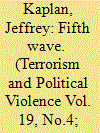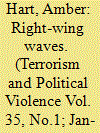| Srl | Item |
| 1 |
ID:
080368


|
|
|
|
|
| Publication |
2007.
|
| Summary/Abstract |
This article builds on David Rapoport's Four Waves Theory by identifying several anomalous movements which did not appear to precisely fit with the internationalist model posited in Rapoport's Four Waves. Specifically, groups which I have called Fifth Wave movements have turned inward, becoming localistic rather than international, and manifest intense ethnic, racial, or tribal mysticism. They are millenarian and chiliastic in nature, and seek to create a new society - based on the creation of new men and women - in a single generation. Fifth Wave movements thus focus strongly on women and see children as the vanguard of their movements. Following this logic, rape is their signature tactic and child abduction their normal recruiting practice. This study posits the pre-state Khmer Rouge in Cambodia as the avatar of the current Fifth Wave, but finds that after a nearly generation-long hiatus, the fifth wave in its fully modern form emerged in Africa with the Lord's Resistance Army in Uganda as its paradigmatic exemplar
|
|
|
|
|
|
|
|
|
|
|
|
|
|
|
|
| 2 |
ID:
190862


|
|
|
|
|
| Summary/Abstract |
The increasing global prominence of right-wing extremism and terrorism has been noted by scholars and government agencies alike. While right-wing terrorism has been documented throughout postwar history, groups have evolved, resulting in diverse materializations of violence perpetrated on behalf of varying ideologies and perceived threats. This paper draws upon Campion’s research into Australian right-wing extremism and terrorism, where three ideological threat narratives were identified. The aim of this research was to determine the applicability of Rapoport’s “wave” theory to the international evolution of extreme right-wing activity. In doing so, Campion’s framework is utilized and a case study analysis undertaken, investigating anti-communist, anti-immigration and anti-Islamic rhetoric on a transnational and transhisto-rical basis. It is argued that waves are found internationally, and that Rapoport’s model is therefore applicable to the right-wing milieu. The paper concludes that the extreme right is on the cusp of the next wave and discusses trends that may inform those in a position to counteract the forthcoming wave of activity. There remains a need for law enforcement and security agencies to monitor right-wing extremism and terrorism activity to remain attuned to the ever-evolving threat as the next wave manifests.
|
|
|
|
|
|
|
|
|
|
|
|
|
|
|
|